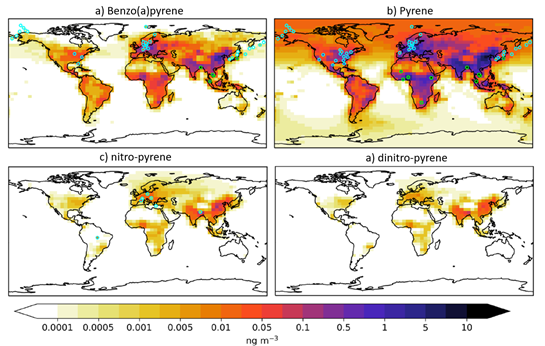Superfund Research Program
Combined Approach Sheds Light on Global Cancer Risk
View Research Brief as PDF(1.1MB)
Release Date: 12/01/2021
![]() subscribe/listen via iTunes, download(5.9MB), Transcript(87KB)
subscribe/listen via iTunes, download(5.9MB), Transcript(87KB)
About 90% of the global lung cancer risk from polycyclic aromatic hydrocarbons (PAHs) does not come from benzo(a)pyrene, according to a study funded by the NIEHS Superfund Research Program (SRP). Some of these compounds are not regularly monitored.
PAHs, emitted into the atmosphere as byproducts of burning organic matter, are a complex mixture of related compounds. Several components of this mixture are known to cause lung cancer. But scientists and regulators tend to represent the entire mixture using a single compound, benzo(a)pyrene, when assessing cancer risk. This approach does not consider other toxic PAHs and their degradation products.
To better assess harm from PAHs, the research team set out to reevaluate whether benzo(a)pyrene is suitable as an indicator for cancer risk of PAHs.
The study was led by Jaime Kelly, Ph.D., a post-doctoral fellow at the Massachusetts Institute of Technology SRP Center working with Noelle Selin, Ph.D.
Assessing the Effects of Multiple Compounds
The researchers used a global-scale atmospheric model, along with data from emissions inventories and atmospheric observations, to estimate concentrations of 16 PAHs around the world. These 16 PAHs are identified as priority pollutants by the U.S. Environmental Protection Agency. They also accounted for highly toxic degradation products of PAHs that are commonly omitted from monitoring and modeling studies, specifically those formed when PAHs react with nitrate in the atmosphere. In total, the team evaluated 48 PAH chemicals.

Then scientists incorporated these parameters to develop a new method to estimate the cancer risk associated with exposure to each PAH chemical based on location and determined each chemical’s individual contribution to the total risk. They found that benzo(a)pyrene contributed to only 11% of the overall risk of developing cancer from PAH exposure globally. The remaining cancer risk came from other PAH chemicals, including 17% from PAH degradation products.
When comparing their novel method with a commonly used method that only uses benzo(a)pyrene as a risk indicator for the whole PAH mixture, they found significant inconsistencies in different regions of the world. For example, they found a 3.5-fold difference between lung cancer risk in Hong Kong and India using the traditional method, but a 12-fold difference using their approach based on the whole PAH mixture. The authors explained that benzo(a)pyrene is only a small contributor to overall cancer risk of the whole mixture.
Improving Cancer Risk Estimates
Based on these findings, the researchers showed that cancer risk conclusions based on modeling benzo(a)pyrene alone can be misleading or erroneous. However, they note that their method has several limitations that should be addressed in future studies to get a more complete picture of the global and regional cancer risk from complex mixtures of PAHs. For example, several toxic PAHs were not included in this study because emissions and toxicity data were not available. The scientists explained that including more PAHs and their degradation products would better account for uncertainties in risk estimates.
The authors suggest regulators and researchers focus on the entire mixture of PAHs in the atmosphere, and not on benzo(a)pyrene as a sole reference compound.
About the Researcher
Kelly was awarded a 2020 K.C. Donnelly Externship Award to work with the National Oceanographic and Atmospheric Administration and Environmental Protection Agency. While there, his model was used to conduct a human and ecological risk assessment and identify the source of PAH emissions. He also investigated how changes in climate, such as increased temperature and rainfall, affect PAH concentrations.
For More Information Contact:
Noelle E Selin
Massachusetts Institute of Technology
77 Massachusetts Avenue
Room E40-379
Cambridge, Massachusetts 02139-4307
Phone: 617-324-2592
Email: selin@mit.edu
To learn more about this research, please refer to the following sources:
- Kelly JM, Ivatt PD, Evans MJ, Kroll JH, Hrdina AI, Kohale I, White FM, Engelward BP, Selin NE. 2021. Global cancer risk from unregulated polycyclic aromatic hydrocarbons. Geohealth 5(9):doi:10.1029/2021GH000401 PMID:34589640 PMCID:PMC8460132
To receive monthly mailings of the Research Briefs, send your email address to srpinfo@niehs.nih.gov.


